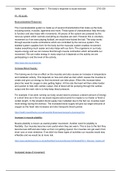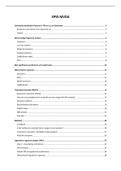and Emotional Disorders
,Inhoudsopgave
Important for the exam...........................................................................................................................................3
Clips lecture 1..........................................................................................................................................................6
Lecture 1: introduction & methods.....................................................................................................................12
Clips lecture 2........................................................................................................................................................14
Lecture 2: Emotion basics and basic emotions...................................................................................................18
Clips lecture 3........................................................................................................................................................22
Lecture 3: Reading faces & bodies......................................................................................................................29
Article lecture 4: Personality disorders across the life course..........................................................................33
Lecture 4: Personality disorders..........................................................................................................................35
Article lecture 5: Titrating the smell of fear.......................................................................................................37
Clips lecture 5........................................................................................................................................................38
Lecture 5: The social neuroscience of smell........................................................................................................41
Clips lecture 6........................................................................................................................................................43
Lecture 6: Understanding others.........................................................................................................................46
Article lecture 7: Testosterone and dominance in humans: behavioral and brain mechanisms...................48
Lecture 7: Hormones & behavior........................................................................................................................50
Clips lecture 8........................................................................................................................................................53
Lecture 8: Interacting with others.......................................................................................................................56
Clips lecture 9........................................................................................................................................................58
Lecture 9: What is love?.......................................................................................................................................61
Clips lecture 10......................................................................................................................................................65
Lecture 10: Groups and identity..........................................................................................................................67
Clips lecture 11......................................................................................................................................................69
Lecture 11: Morality and antisocial behavior....................................................................................................71
Clips lecture 12......................................................................................................................................................72
Lecture 12: Developmental social neuroscience.................................................................................................75
2
, Important for the exam
Lecture 1
- Explain what social neuroscience is
- Explain the evolutionary theories of the social brain
- Explain the triune brain model
- Explain the concept of modularity in relation to the social brain
- Methods (from clips)
Lecture 2
- Autonomous nervous system and hypothalamus
- Neurotransmitters, peptides, hormones
- Amygdala, Striatum, Insula, vmPFC
- Theories of emotion
- Basic emotions
Lecture 3
- There seems to be some preferential processing in the right posterior superior temporal
sulcus for emotion detection/recognition
- Gaze detection fulfills important social functions and is an innate human ability
- Gaze orienting is context-, person and culture-dependent
- Gaze is processed:
o By medial and inferior frontal, superior temporal, temporoparietal and
subcortical brain regions
o Following a fast subcortical pathway and a more analytical cortical pathway
Lecture 4
- Personality disorders are enduring, inflexible, and pervasive patterns of behavior
affecting cognition, emotions, relationships, or impulse control, causing distress or
impairment.
- Organized into three clusters
- Develop from a mix of genetic, temperamental, and environmental factors (e.g.,
childhood adversity).
- Schemas: Mental frameworks that influence behavior; maladaptive schemas (e.g.,
abandonment, entitlement) underlie personality disorders.
- Brain differences: Reduced grey matter in the amygdala and hippocampus in BPD, but
unclear if these are causal or consequential.
- Reverse inference (e.g., diagnosing via brain scans) is not valid for personality
disorders.
Lecture 5
- Humans, once thought to have poor smell abilities, share remarkable smell skills with
other animals.
- Functions of smell: edibility judgment, hazard avoidance, social communication (e.g.,
identity, gender, emotions).
- Fear odors synchronize receivers with senders, activating the amygdala, fusiform
gyrus, and ventromedial prefrontal cortex.
3
, - Pheromones: Hexadecanoic acid universally triggers fear perception in faces across
cultures (De Groot et al., 2023).
- Neural mechanisms: Piriform cortex supports odor learning; cortical amygdala drives
instinctive responses.
- Urbach-Wiethe Disease (UWD): Patients with amygdala damage show heightened
responses to innate fear odors, emphasizing the basolateral amygdala’s role in fear
regulation.
Lecture 6
- Simulation cause mimicry, rather than being a consequence
- Mirror neurons may result from action-outcome learning
- Learned relations between actions and outcomes in the world can be quite flexible
- Mirror neurons may not “mirror” but rather be motor neurons that are activated by
action goals in the situation at hand
Lecture 7
- Explain how testosterone can promote dominance
- Explain how the effect of testosterone on the brain contributes to that
- Explain how cortisol fits into this behavior/brain model
- Explain how this relates to social anxiety
Lecture 8
- Difference between emotion commitment and social orientation accounts of rejection
behavior/costly punishment
- Difference between UG and IG
- When and in who MFN (expectancy) and frowning is amplified
- How MFN and frowning predict rejection behavior/costly punishment
Lecture 9
- Feelings of love are orchestrated by increases and decreases in hormones associated
with social behavior and reward
- Love causes increases in reward-related brain activity and decreases in judgement- and
mentalizing-related brain activity
- Romantic love is likely an evolutionary consequence of maternity love
- The hypothalamus may play a special role in sexual arousal in romantic relationships
- Long-lasting grief is associated with a malfunctioning reward response in the NAcc
Lecture 10
- Self-Concept: Includes the sensorimotor self (agency), ongoing self (traits, memories),
and collective self (group membership).
- Social Identity Theory: Defined by categorization (grouping
people), identification (aligning with a group), and comparison (evaluating groups).
- Self-Referential Processing: Activates the mPFC for self-judgment; influenced by
cultural factors.
- Morality and Bias: Moral framing reduces outgroup bias. Ingroup moral feedback
strengthens cohesion and reduces prejudice.
- Group Dynamics: Brain regions like the amygdala, ACC, and dlPFC regulate bias.
Group membership can override race bias.
- Intergroup Sensitivity: Ingroup criticism feels more personal, especially on moral
issues, with heightened neural responses.
4











